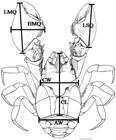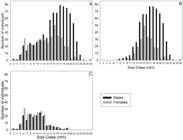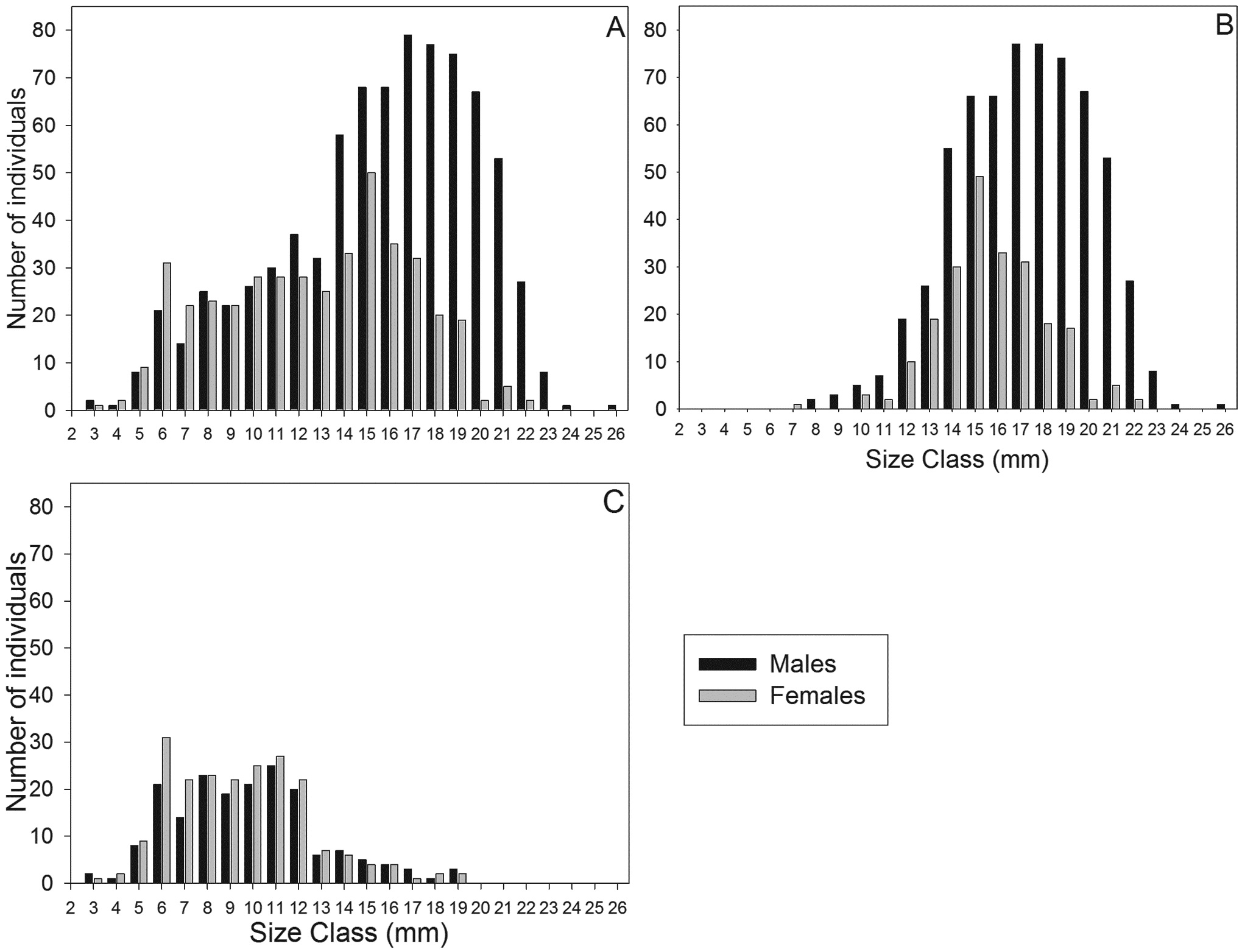|
A. castro
|
Handnet |
Males > Females |
Swiech-Ayoub and Masunari (2001)Swiech-Ayoub, B.P. and Masunari, S., 2001. Flutuações temporal e espacial de abundância e composição de tamanho de . Aegla castro Schmitt (Crustacea, Anomura, Aeglidae) no Buraco do Padre, Ponta Grossa, Paraná, BrasilRevista Brasileira de Zoologia, vol. 18, no. 3, pp. 1003-1017.. http://dx.doi.org/10.1590/S0101-81752001000300032.
http://dx.doi.org/10.1590/S0101-81752001...
|
|
A. castro
|
Handnet |
Absent |
Fransozo et al. (2003)Fransozo, A., Costa, R.C., Reigada, A.L.D. and Nakagaki, J.M., 2003. Population structure of Schmitt, 1942 (Crustacea: Anomura: Aeglidae) from Itatinga (SP), Brazil. Aegla castroActa Limnologica Brasiliensia, vol. 15, no. 1, pp. 13-20. http://dx.doi.org/101590/S1984-46702009000100004
http://dx.doi.org/101590/S1984-467020090...
|
|
A. paulensis
|
Handnet |
Males > Females |
Lopez (1965)Lopez, M.T., 1965. Estúdos biológicos en Schmitt. . Aegla odebrechtii paulensisBoletim de Zoologia da Faculdade de FilosofiaCiências e Letras da USP, vol. 25, pp. 301-314.
|
|
A. franciscana
|
Handnet |
Males > Females |
Gonçalves et al. (2006)Gonçalves, R.S., Castiglioni, D.S. and Bond-Buckup, G., 2006. Ecologia populacional de Aegla franciscana (Crustacea, Decapoda, Anomura) em São Francisco de Paula, RS, Brasil. Iheringia, Série Zoologia, vol. 96, no. 1, pp. 109-114. http://dx.doi.org/101590/S0073-47212006000100019.
http://dx.doi.org/101590/S0073-472120060...
|
|
A. georginae
|
Trap |
Males > Females |
Currente study |
|
A. georginae
|
Handnet |
Absent |
Currente study |
|
A. grisella
|
Trap + Handnet |
Males > Females |
Copatti et al. (2015)Copatti, C.E., Machado, J.V.V. and Trevisan, A., 2015. Morphological variation in the sexual maturity of three sympatric aaeglids in a river in southern Brazil. Journal of Crustacean Biology, vol. 35, no. 1, pp. 59-67. http://dx.doi.org/10.1163/1937240X-00002303.
http://dx.doi.org/10.1163/1937240X-00002...
|
|
A. leptodactyla
|
Handnet |
Males > Females |
Noro and Buckup (2002)Noro, C.K. and Buckup, L., 2002. Biologia reprodutiva e ecologia de . Aegla leptodactyla Buckup & Rossi, 1977 (Crustacea, Anomura, Aeglidae)Revista Brasileira de Zoologia, vol. 19, no. 4, pp. 1063-1074.. http://dx.doi.org/10.1590/S0101-81752002000400011.
http://dx.doi.org/10.1590/S0101-81752002...
|
|
A. longirostri
|
Handnet |
Males > Females |
Colpo et al. (2005)Colpo, K.D., Ribeiro, L.D. and Santos, S., 2005. Population biology of the freshwater Anomura (Aeglidae) from South Brazilian streams. Aegla longirostriJournal of Crustacean Biology, vol. 25, no. 3, pp. 495-499.. http://dx.doi.org/10.1651/C-2543.
http://dx.doi.org/10.1651/C-2543...
|
|
A. ludwigi
|
Trap + Handnet |
Males > Females |
Copatti et al. (2015)Copatti, C.E., Machado, J.V.V. and Trevisan, A., 2015. Morphological variation in the sexual maturity of three sympatric aaeglids in a river in southern Brazil. Journal of Crustacean Biology, vol. 35, no. 1, pp. 59-67. http://dx.doi.org/10.1163/1937240X-00002303.
http://dx.doi.org/10.1163/1937240X-00002...
|
|
A. manuinflata
|
Trap + Handnet |
Males > Females |
Trevisan and Santos (2014)Trevisan, A. and Santos, S., 2014. Population dynamics of Aegla manuinflata Bond-Buckup and Santos 2009 (Decapoda: Aeglidae), an threatened species. Acta Limnologica Brasileira, vol. 26, no. 2, pp. 154-162. http://dx.doi.org/101590/S2179-975X2014000200006.
http://dx.doi.org/101590/S2179-975X20140...
|
|
A. parana
|
Trap |
Males > Females |
Grabowski et al. (2013)Grabowski, R.C., Santos, S. and Castilho, A.L., 2013. Reproductive ecology and size of sexual maturity in the anomuran crab (Decapoda: Aeglidae). Aegla paranaJournal of Crustacean Biology, vol. 33, no. 3, pp. 332-338. http://dx.doi.org/10.1163/1937240X-00002148.
http://dx.doi.org/10.1163/1937240X-00002...
|
|
A. perobae
|
Handnet |
Males > Females |
Rodrigues and Hebling (1978)Rodrigues, W. and Hebling, N.J., 1978. Estudos biológicos em Hebling & Rodrigues, 1977 (Decapoda, Anomura) Rio de Janeiro. Aegla perobaeBrazilian Journal of Biology = Revista Brasileira de Biologia, vol. 38, no. 2, pp. 383-390.
|
|
A. platensis
|
Handnet |
Females > Males |
Bueno and Bond-Buckup (2000)Bueno, A.A.P. and Bond-Buckup, G., 2000. Dinâmica populacional de . Aegla platensis Schmitt (Crustacea, Decapoda, Aeglidae)Revista Brasileira de Zoologia, vol. 17, no. 1, pp. 43-49.. http://dx.doi.org/10.1590/S0101-81752000000100005.
http://dx.doi.org/10.1590/S0101-81752000...
|
|
A. platensis
|
Trap |
Males > Females |
Dalosto et al. (2014)Dalosto, M.M., Palaoro, A.V., Oliveira, D., Samuelsson, E. and Santos, S., 2014. Population biology of Aegla platensis (Decapoda: Anomura: Aeglidae) in a tributary of the Uruguay River, state of Rio Grande do Sul, Brazil. Zoologia, vol. 31, no. 3, pp. 215-222.. http://dx.doi.org/10.1590/S1984-46702014000300002.
http://dx.doi.org/10.1590/S1984-46702014...
|
|
A. platensis
|
Handnet |
Females > Males |
Dalosto et al. (2014)Dalosto, M.M., Palaoro, A.V., Oliveira, D., Samuelsson, E. and Santos, S., 2014. Population biology of Aegla platensis (Decapoda: Anomura: Aeglidae) in a tributary of the Uruguay River, state of Rio Grande do Sul, Brazil. Zoologia, vol. 31, no. 3, pp. 215-222.. http://dx.doi.org/10.1590/S1984-46702014000300002.
http://dx.doi.org/10.1590/S1984-46702014...
|
|
A. platensis
|
Trap + Handnet |
Males > Females |
Copatti et al. (2015)Copatti, C.E., Machado, J.V.V. and Trevisan, A., 2015. Morphological variation in the sexual maturity of three sympatric aaeglids in a river in southern Brazil. Journal of Crustacean Biology, vol. 35, no. 1, pp. 59-67. http://dx.doi.org/10.1163/1937240X-00002303.
http://dx.doi.org/10.1163/1937240X-00002...
|
|
A. schmitti
|
Trap + Handnet |
Males > Females |
Teodósio and Masunari (2009)Teodósio, E.A.O. and Masunari, S., 2009. Estrutura populacional de . Aegla schmitti (Crustacea: Anomura: Aeglidae) nos reservatórios dos Mananciais da Serra, Piraquara, Paraná, BrasilZoologia, vol. 26, no. 1, pp. 19-24.. http://dx.doi.org/10.1590/S1984-46702009000100004.
http://dx.doi.org/10.1590/S1984-46702009...
|

 Thumbnail
Thumbnail
 Thumbnail
Thumbnail
 Thumbnail
Thumbnail
 Thumbnail
Thumbnail



